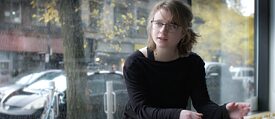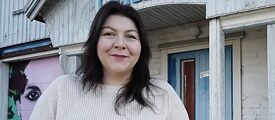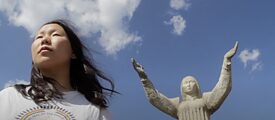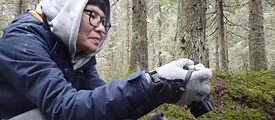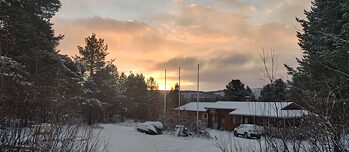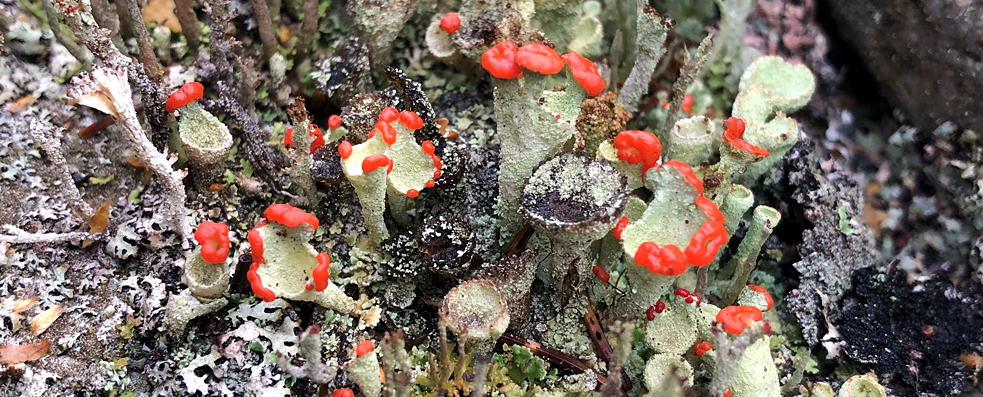Despite the difficult circumstances in the pandemic and the related restrictions on travel, most of the planned visits could take place. A number of fantastic works have been created and the exchange with artists in a different environment has mutually enriched their artistic work. In words and images, this series of videos will introduce you to the work of the residents as part of the project.
Circumpolar perspectives
The climate crisis threatens all societies, particularly those living in the circumpolar north. While indigenous knowledges are increasingly recognized in international discourses, they are especially considered in response to the challenge of climate change. The program acknowledges the connection and interrelation between the urgency of the climate crisis and the relevance of indigenous rights and self-determination. The project is a starting point for knowledge-sharing and connecting discourses in the North with those in the South.
Established and emerging residency programs in Nunavik, Finland, Yakutia, Norway and Sápmi are forming a network to host artists and researchers within the frame of the project.
The residency aims to:
- connect and develop an exchange between residency programs in the circumpolar north.
- develop a circular exchange practice with the residents, providing the opportunity for them to interact and exchange their knowledges and practices with fellow residents and local communities.
The residents are individuals from diverse disciplines and practices (i.e. artists, researchers, writers, curators, storytellers, artisans, filmmakers, cultural workers, architects, scientists) who are indigenous or have a strong knowledge of and relation to indigenous communities in the circumpolar north. The residents will be invited to do a public presentation of their practice to the local communities.
Marie-Andrée Gill
 Marie-Andrée Gill
| © Sophie Gagnon Bergeron
Marie-Andrée Gill is Pekuakamishkueu and identifies primarily as a poet. Mother, friend, lover, student, her research and creative work concern transpersonal and decolonial love. Bridging kitsch and existentialism, her writing is rooted in territory and interiority, combining her Quebec and Ilnu identities. She is the author of three books: Béante, Frayer, and Chauffer le dehors. In 2018 she was the winner of the Indigenous Voices Award. She lives in L’Anse-Saint-Jean, Quebec. Marie-Andreé Gill will be a resident in Sápmi and in Røst.
Marie-Andrée Gill
| © Sophie Gagnon Bergeron
Marie-Andrée Gill is Pekuakamishkueu and identifies primarily as a poet. Mother, friend, lover, student, her research and creative work concern transpersonal and decolonial love. Bridging kitsch and existentialism, her writing is rooted in territory and interiority, combining her Quebec and Ilnu identities. She is the author of three books: Béante, Frayer, and Chauffer le dehors. In 2018 she was the winner of the Indigenous Voices Award. She lives in L’Anse-Saint-Jean, Quebec. Marie-Andreé Gill will be a resident in Sápmi and in Røst.
Marije Jenssen
 Marije Jenssen
| © Marije Jenssen
Marije Jenssen is a Norwegian-Sámi painter and installation artist from Balsfjord, Norway. Her work is inspired by Northern Norwegian landscape, lifestyles and traditional materials and techniques within weaving. Her focus lies on highlighting the processes of cultivating traditional resources in a sustainable contemporary context. Marije graduated from UWC Adriatic (2014) and Kunstskolen i Bergen (2018). She spent the first two years of her Visual Art Bachelor at KMD in Bergen (2018-'20), and completed her degree at Tromsø Art Academy in May 2021. Marije Jenssen will be a resident in Nunavik.
Marije Jenssen
| © Marije Jenssen
Marije Jenssen is a Norwegian-Sámi painter and installation artist from Balsfjord, Norway. Her work is inspired by Northern Norwegian landscape, lifestyles and traditional materials and techniques within weaving. Her focus lies on highlighting the processes of cultivating traditional resources in a sustainable contemporary context. Marije graduated from UWC Adriatic (2014) and Kunstskolen i Bergen (2018). She spent the first two years of her Visual Art Bachelor at KMD in Bergen (2018-'20), and completed her degree at Tromsø Art Academy in May 2021. Marije Jenssen will be a resident in Nunavik.
Tanja Maria Koistinen
 Tanja Maria Koistinen
| © Touko Hujanen
Tanja studies diverse identities in the North. Using multi-disciplinary working methods, such as artist-led community art workshops, environmental art and art & science collaboration, Tanja builds her art in the forms of visual arts, installation, documentation photography and storytelling through self-reflection, simplifying, portraying and color. Tanja Koistinen is a lappish person, who is connected to Inari Sámi culture through her ancestry, family homeland (Njellim, Sapmi) and livelihood. Currently she works and lives in Äkäslompolo, North-West Lapland, Finland.Tanja Koistinen will be a resident in Sakha.
Tanja Maria Koistinen
| © Touko Hujanen
Tanja studies diverse identities in the North. Using multi-disciplinary working methods, such as artist-led community art workshops, environmental art and art & science collaboration, Tanja builds her art in the forms of visual arts, installation, documentation photography and storytelling through self-reflection, simplifying, portraying and color. Tanja Koistinen is a lappish person, who is connected to Inari Sámi culture through her ancestry, family homeland (Njellim, Sapmi) and livelihood. Currently she works and lives in Äkäslompolo, North-West Lapland, Finland.Tanja Koistinen will be a resident in Sakha.
Tatiana Filippova
 Tatiana Filippova
| © Tatiana Filippova
Tatiana Philippova is a writer, focused on fragmentary prose. That’s how she as a queer person, a lesbian and a Sakha woman recollects her «self» by decolonizing her experience. Her grandparents were forced to leave their land during the WW II, now global climate change gradually transforms their former home into some other place. Can modern Indigenous people of Yakutia find new homeland elsewhere or should they continue to live on their ancestors land – this is the question she tries to answer in her expression. Tatiana is a winner of Znamya literature magazine award 2020. She lives in Yakutsk.Tatiana Filippova will be a resident at Malakta and in Røst.
Tatiana Filippova
| © Tatiana Filippova
Tatiana Philippova is a writer, focused on fragmentary prose. That’s how she as a queer person, a lesbian and a Sakha woman recollects her «self» by decolonizing her experience. Her grandparents were forced to leave their land during the WW II, now global climate change gradually transforms their former home into some other place. Can modern Indigenous people of Yakutia find new homeland elsewhere or should they continue to live on their ancestors land – this is the question she tries to answer in her expression. Tatiana is a winner of Znamya literature magazine award 2020. She lives in Yakutsk.Tatiana Filippova will be a resident at Malakta and in Røst.
Svetlana Romanova
 Svetlana Romanova
| © Svetlana Romanova
Svetlana Romanova was born in Yakutsk, Russia and studied visual arts in Los Angeles. She has received her BFA at Otis College of Art and Design, and MFA at California Institute of the Arts. From 2009 to 2014, she lived and worked in arts education in California. After returning to Siberia in 2015, she started working on several film projects about her hometown and regions around it. Her video project is an investigation of two local Indigenous groups that she belongs to (Evenk and Sakha). Her work has been screened and shown in various art venues in California and Russia. Svetlana Romanova will be a resident in Nunavik and in Sápmi.
Svetlana Romanova
| © Svetlana Romanova
Svetlana Romanova was born in Yakutsk, Russia and studied visual arts in Los Angeles. She has received her BFA at Otis College of Art and Design, and MFA at California Institute of the Arts. From 2009 to 2014, she lived and worked in arts education in California. After returning to Siberia in 2015, she started working on several film projects about her hometown and regions around it. Her video project is an investigation of two local Indigenous groups that she belongs to (Evenk and Sakha). Her work has been screened and shown in various art venues in California and Russia. Svetlana Romanova will be a resident in Nunavik and in Sápmi.
Nancy (Niap) Saunders
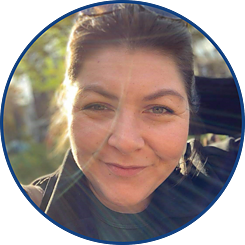 Nancy (Niap) Saunders
| © Nancy Saunders
Based in Montreal, QC, Niap (Nancy Saunders) is an award-winning multidisciplinary artist who divides her time between the city and her home community of Kuujjuaq, Nunavik – a place that continues to deeply influence her work. Working across media, Niap thoughtfully investigates her cultural heritage and identity as an Inuk woman through her practice. Working across painting, performance, sculpture and photography, Niap has produced a wide ranging body of work from murals to immersive installations to portraiture. Niap will be a resident in Sakha and at Malakta.
Nancy (Niap) Saunders
| © Nancy Saunders
Based in Montreal, QC, Niap (Nancy Saunders) is an award-winning multidisciplinary artist who divides her time between the city and her home community of Kuujjuaq, Nunavik – a place that continues to deeply influence her work. Working across media, Niap thoughtfully investigates her cultural heritage and identity as an Inuk woman through her practice. Working across painting, performance, sculpture and photography, Niap has produced a wide ranging body of work from murals to immersive installations to portraiture. Niap will be a resident in Sakha and at Malakta.
¹ The title of the project comes from the long battle of Inuit to have their rights linked to climate change. The book of the same name by Sheila Watt-Cloutier (2015, Allen Lane Publication), testifies of her pioneering work in connecting climate change to human rights with the Inuit legal petition she and 62 fellow Inuit from Canada and Alaska launched to the Inter American Commission on Human Rights in Washington DC in 2005. Inuit leaders and climate change activists use this expression to capture their struggle and hope for political leaders to realize their communities are being severely impacted by climate change. Although the Commission did not go ahead with the Inuit petition they did have a historical hearing on the legal impacts and connections between climate change and human rights. Okalik Eegeesiak, Former Chair of the Inuit Circumpolar Council (ICC) used the expression in her discourse at the United Nations Framework Convention on Climate Change COP 21 December 3, 2015 in Paris, France: “Climate change is not just an environmental issue it is a human rights issue and the melting of the Arctic is impacting all aspects of Inuit life, therefore, the final text must make the rights of Indigenous peoples operative and keep it in Article 2.2. We have the right to be cold” argued Eegeesiak.
The Goethe-Institut
The Right To Be Cold program has been developed with advisory from Tero Mustonen (Snowchange) and Elin Már Øyen Vister (Røst AiR). The Goethe-Intitut would also like to acknowledge the contributions of everyone currently involved: Aka Niviâna, Assinajaq, Avataq Cultural Institute, Dáiddadállu, Giovanna Esposito Yussif, Malakta, Patricia Rodas, Sámi Dáiddaguovddáš, Stina Aikio, Sunna Nousuniemi, The National Art Museum of the Republic of Sakha.
The residency chain is thematically part of the dossier The Right To Be Cold, with a growing number of texts by people from the circumpolar North under the motto « Climate Justice for the Arctic ». This is in turn embedded in the online magazine Ecologues - How We Survive the Age of Man, with contributions from experts around the world.


